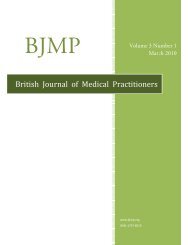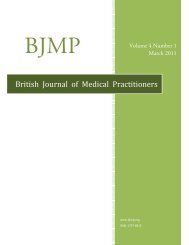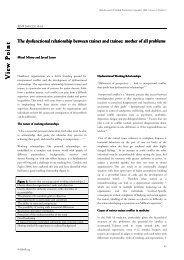R esearch A rticle - British Journal of Medical Practitioners
R esearch A rticle - British Journal of Medical Practitioners
R esearch A rticle - British Journal of Medical Practitioners
You also want an ePaper? Increase the reach of your titles
YUMPU automatically turns print PDFs into web optimized ePapers that Google loves.
<strong>British</strong> <strong>Journal</strong> <strong>of</strong> <strong>Medical</strong> <strong>Practitioners</strong>, March 2013, Volume 6, Number 1<br />
therapy is not based on the actual coagulation state because<br />
conventional laboratory test results are usually not available<br />
for 45 to 60 minutes. Thromboelastography and rotational<br />
thromboelastometry are point-<strong>of</strong>-care coagulation tests. A<br />
good correlation has been shown between<br />
thromboelastometric and conventional coagulation tests, and<br />
the use <strong>of</strong> these in massive bleeding in non-obstetric patients<br />
is widely practiced and it has been proven to be cost-effective.<br />
• A 2006 guideline from the <strong>British</strong> Committee for Standards<br />
in Haematology 1, 4 summarizes the main therapeutic goals <strong>of</strong><br />
management <strong>of</strong> massive blood loss is to maintain:<br />
• Haemoglobin > 8g/dl<br />
• Platelet count > 75 x 10 9 /l<br />
• Prothrombin < 1.5 x mean control<br />
• activated prothrombin times < 1.5 x mean control<br />
• Fibrinogen > 1.0 g/l.<br />
• In addition, the Confidential Enquiry into Maternal and<br />
Child Health recommends that women with known risk<br />
factors for PPH should not be delivered in a hospital without<br />
a blood bank on site 1 .<br />
• Transfer to theatre.<br />
• Non-surgical intervention for uterine atony.<br />
• Bimanual uterine compression (rubbing up the fundus) to<br />
stimulate contractions.<br />
• Ensure bladder is empty (Foley catheter, leave in place). ‘Rub<br />
up ‘the uterus<br />
• Syntocinon 5 units by slow intravenous injection (may have<br />
repeat dose).<br />
• Ergometrine 0.5 mg by slow iv/im injection (contraindicated<br />
in women with hypertension) 16 .<br />
• Syntocinon infusion (40 units over 4 hours).<br />
• Carboprost 0.25 mg by intramuscular injection repeated at<br />
intervals <strong>of</strong> not less than 15 minutes to a maximum <strong>of</strong> 8 doses<br />
(contraindicated in women with asthma).<br />
• Direct intramyometrial injection <strong>of</strong> carboprost 0.5 mg im<br />
(Haemobate or Prostaglandin F2a) with responsibility <strong>of</strong> the<br />
administering clinician as it is not recommended for<br />
intramyometrial use. Can be repeated up to 5 doses<br />
(contraindicated in women with asthma, may cause<br />
bronchospasm, flushing & hypertension 17 ).<br />
• Misoprostol 1000 micrograms rectally.<br />
• If pharmacological measures fail to control the haemorrhage,<br />
initiate surgical haemostasis sooner than later.<br />
Surgical treatment and other interventions<br />
The most common cause <strong>of</strong> primary PPH is uterine atony.<br />
However, clinical examination must be undertaken to exclude<br />
other or additional causes:<br />
• Retained products (placenta, membranes, clots)<br />
• Vaginal/cervical lacerations or hematoma<br />
• Ruptured uterus<br />
• Broad ligament hematoma<br />
• Extra genital bleeding (for example, subcapsular liver rupture)<br />
• Uterine inversion.<br />
Intrauterine balloon tamponade is an appropriate first line<br />
‘surgical’ intervention for most women where uterine atony is<br />
the only or main cause <strong>of</strong> haemorrhage. If this fails to stop the<br />
bleeding, the following conservative surgical interventions may<br />
be attempted, depending on clinical circumstances and available<br />
expertise:<br />
• Balloon tamponade (Bakri/Rusch balloon, Foley’s/condom<br />
catheter, Sengstaken-Blakemore tube 18-21<br />
• Haemostatic brace suturing (such as B-Lynch or modified<br />
compression sutures).<br />
• Bilateral ligation <strong>of</strong> uterine arteries.<br />
• Bilateral ligation <strong>of</strong> internal iliac (hypogastric) arteries.<br />
• Selective arterial embolisation or balloon occlusion<br />
radiologically.<br />
• Compression/ clamping aorta to buy time.<br />
• Uterine replacement if uterine inversion<br />
It is recommended that a laminated diagram <strong>of</strong> the brace<br />
technique be kept in theatre. Resort to hysterectomy sooner<br />
rather than later (especially in cases <strong>of</strong> placenta accreta or<br />
uterine rupture). A second consultant clinician should be<br />
involved in the decision for hysterectomy.<br />
Interventional Radiological techniques<br />
Interventional techniques are gaining popularity if the facilities<br />
& expertise exist and are especially useful for the anticipated<br />
massive bleeds e.g. planned LSCS in a woman with anticipated<br />
placenta accrete. Though evidence <strong>of</strong> effectiveness is still<br />
limited, there are increasing case reports <strong>of</strong> its successful use.<br />
This suggests that prophylactic arterial catherisation (with a<br />
view to embolisation) could be considered where facilities<br />
permit until such time as further evidence becomes available 22-<br />
28<br />
.<br />
• Bilateral internal iliac artery balloons may be placed electively<br />
& inflated at C. section/ should bleed occur.<br />
• Selective pelvic artery (internal iliac arteries, anterior division<br />
<strong>of</strong> internal iliac or uterine artery) embolisation can be<br />
performed.<br />
• Complications appear rarely & include: haematoma, false<br />
aneurysms & lower limb ischemia.<br />
Interventional radiology may be considered in cases <strong>of</strong> placenta<br />
praevia with accreta if intra-arterial balloons can be placed in<br />
the radiology department before the woman goes to theatre for<br />
caesarean section. Follow up studies <strong>of</strong> women who had<br />
undergone arterial embolisation for control <strong>of</strong> PPH suggest that<br />
the intervention does not impair subsequent menstruation and<br />
fertility 29, 30 .<br />
BJMP.org<br />
19







